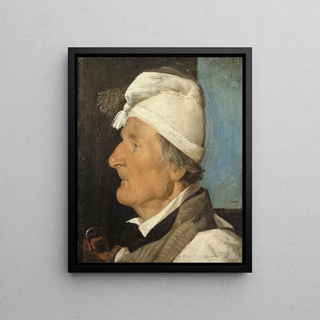Art print | Le Menuisier - Jean-Jacques Henner


View from behind

Frame (optional)
Art print Le Menuisier - Jean-Jacques Henner – Captivating introduction
In the rich and fascinating universe of art, some works stand out for their ability to capture the very essence of humanity. "Le Menuisier" by Jean-Jacques Henner is one of those creations that transcend time. Painted in 1873, this painting evokes a palpable intimacy, a frozen moment where the craftsman, in full concentration, seems to dialogue with the wood he shapes. The soft light bathing the scene gives the work a warm, almost familiar atmosphere, inviting the viewer to enter the world of craftsmanship and creativity. This art print, faithful to the original, allows appreciation of the depth of this iconic work while paying tribute to the virtuosity of its creator.
Style and uniqueness of the work
Jean-Jacques Henner's style is characterized by a remarkable mastery of light and shadow, which gives his characters an almost sculptural dimension. In "Le Menuisier," the color palette chosen by the artist evokes a delicate harmony, where warm tones intertwine to create a soothing atmosphere. The posture of the carpenter, both focused and natural, reveals a touching humanity, while the meticulous details of the wood and tools testify to the attention given to craftsmanship. Henner, influenced by the realist movement, manages to combine a faithful representation of the subject with an almost poetic approach to reality. This painting thus fits into an artistic tradition that values manual work and the authenticity of human emotions.
The artist and his influence
Jean-Jacques Henner, born in 1829 in Strasbourg, is an artist whose work profoundly marked the French artistic scene of the 19th century. Trained at the École des Beaux-Arts, he established himself through his unique style and his ability to capture moments of life with rare sensitivity. Henner was also influenced by the masters of Flemish and Italian painting, which is reflected in his subtle use of light and colors. His career, marked by success, earned him numerous distinctions, but it is his

Matte finish

View from behind

Frame (optional)
Art print Le Menuisier - Jean-Jacques Henner – Captivating introduction
In the rich and fascinating universe of art, some works stand out for their ability to capture the very essence of humanity. "Le Menuisier" by Jean-Jacques Henner is one of those creations that transcend time. Painted in 1873, this painting evokes a palpable intimacy, a frozen moment where the craftsman, in full concentration, seems to dialogue with the wood he shapes. The soft light bathing the scene gives the work a warm, almost familiar atmosphere, inviting the viewer to enter the world of craftsmanship and creativity. This art print, faithful to the original, allows appreciation of the depth of this iconic work while paying tribute to the virtuosity of its creator.
Style and uniqueness of the work
Jean-Jacques Henner's style is characterized by a remarkable mastery of light and shadow, which gives his characters an almost sculptural dimension. In "Le Menuisier," the color palette chosen by the artist evokes a delicate harmony, where warm tones intertwine to create a soothing atmosphere. The posture of the carpenter, both focused and natural, reveals a touching humanity, while the meticulous details of the wood and tools testify to the attention given to craftsmanship. Henner, influenced by the realist movement, manages to combine a faithful representation of the subject with an almost poetic approach to reality. This painting thus fits into an artistic tradition that values manual work and the authenticity of human emotions.
The artist and his influence
Jean-Jacques Henner, born in 1829 in Strasbourg, is an artist whose work profoundly marked the French artistic scene of the 19th century. Trained at the École des Beaux-Arts, he established himself through his unique style and his ability to capture moments of life with rare sensitivity. Henner was also influenced by the masters of Flemish and Italian painting, which is reflected in his subtle use of light and colors. His career, marked by success, earned him numerous distinctions, but it is his






